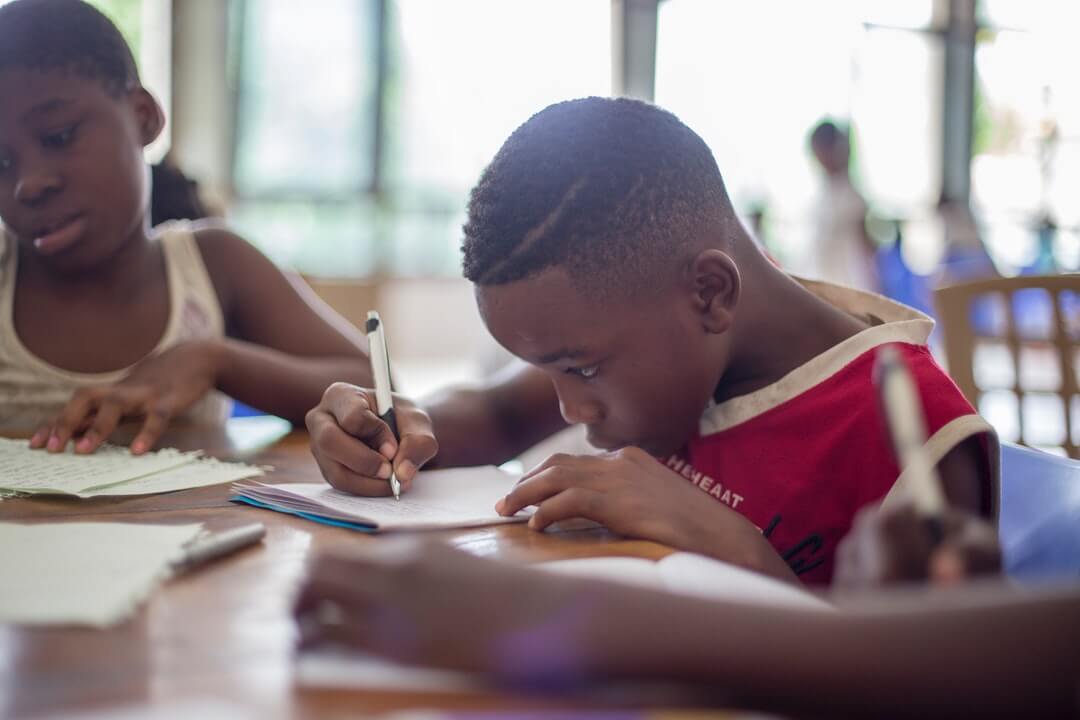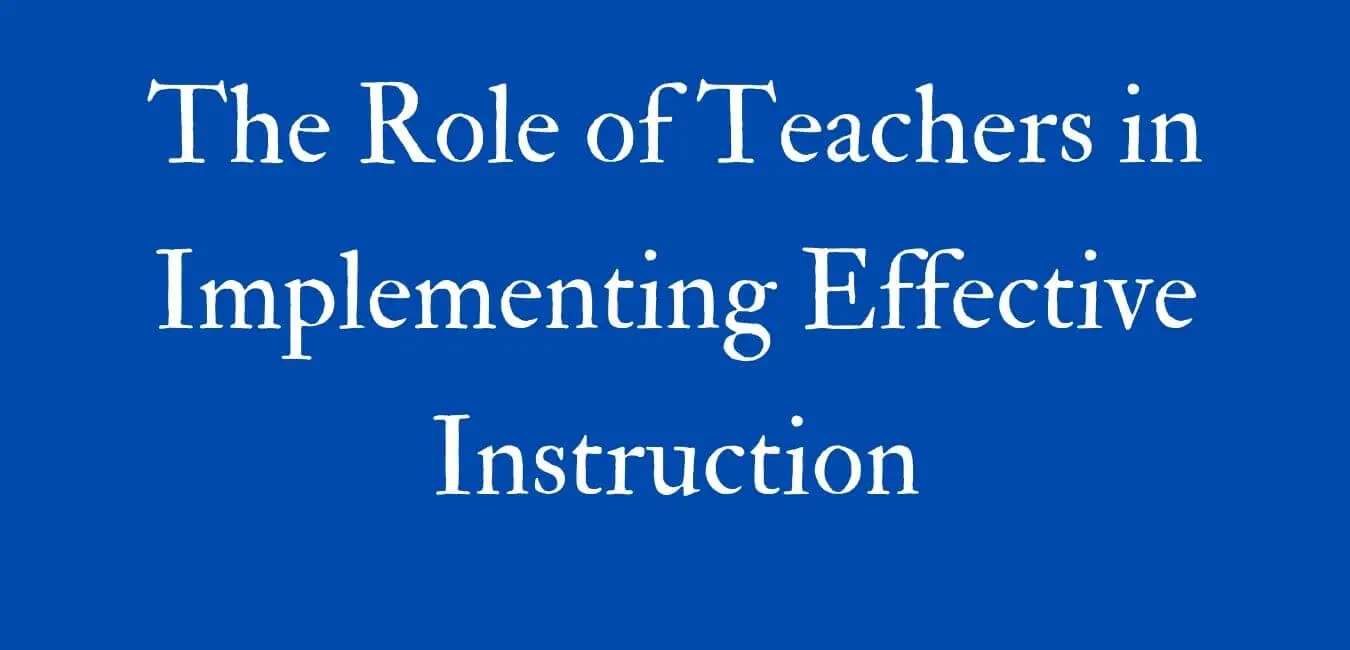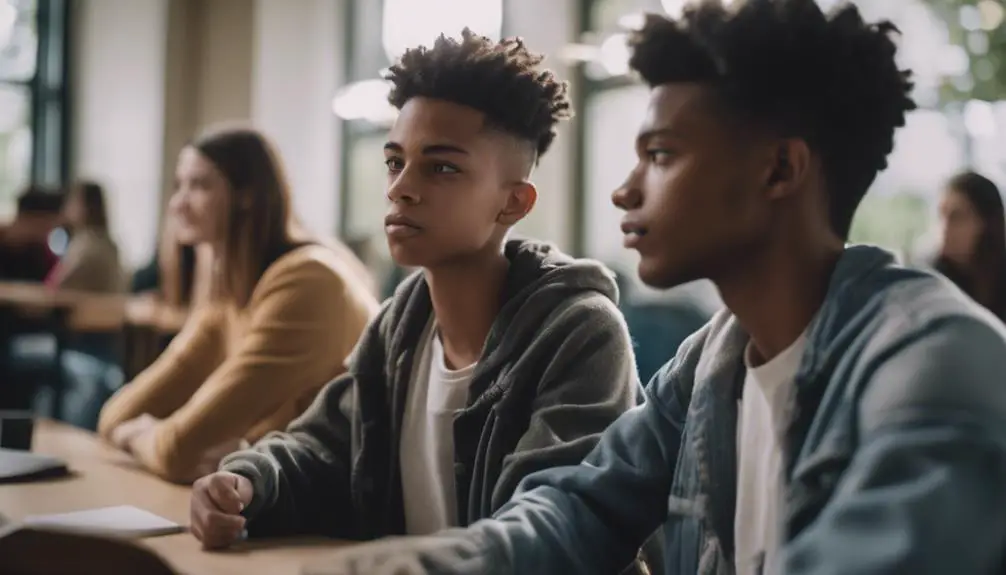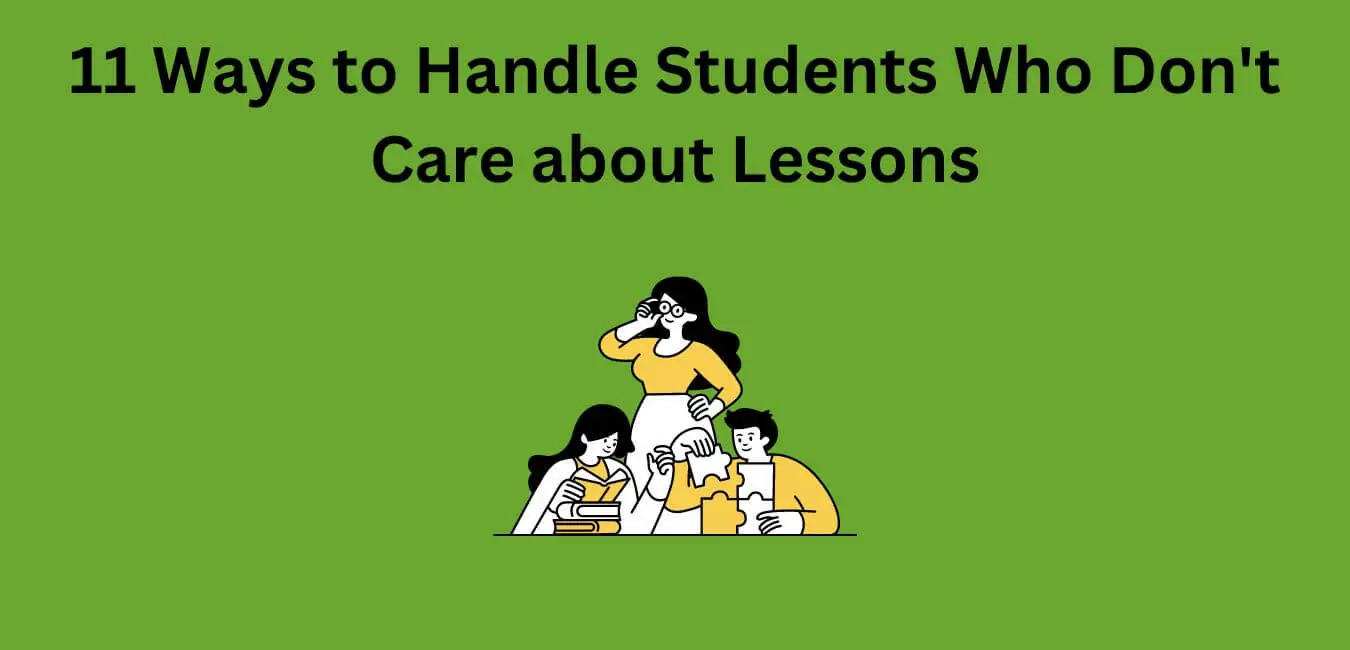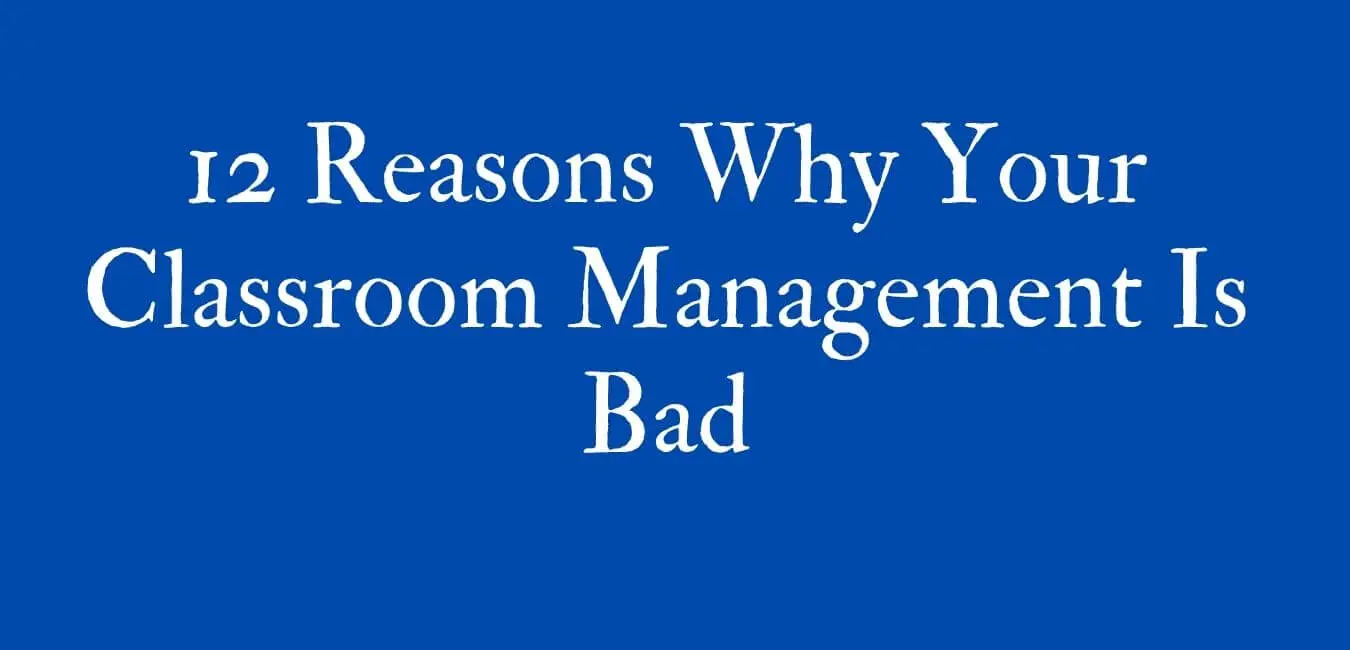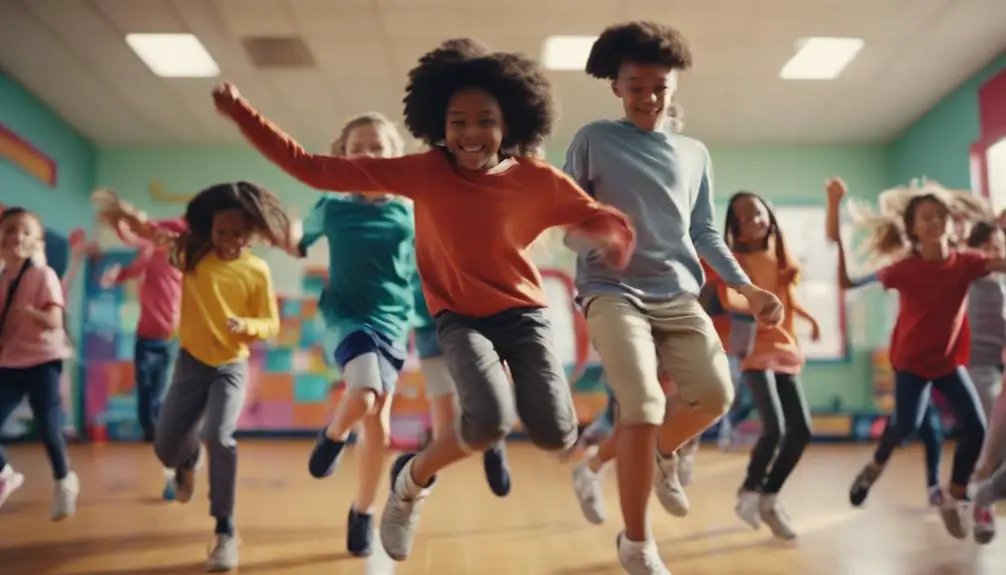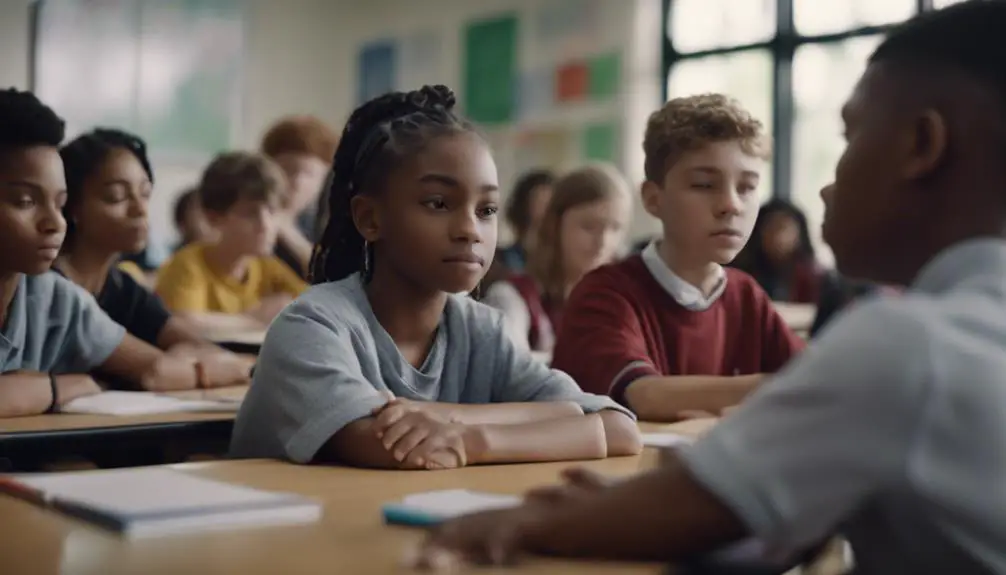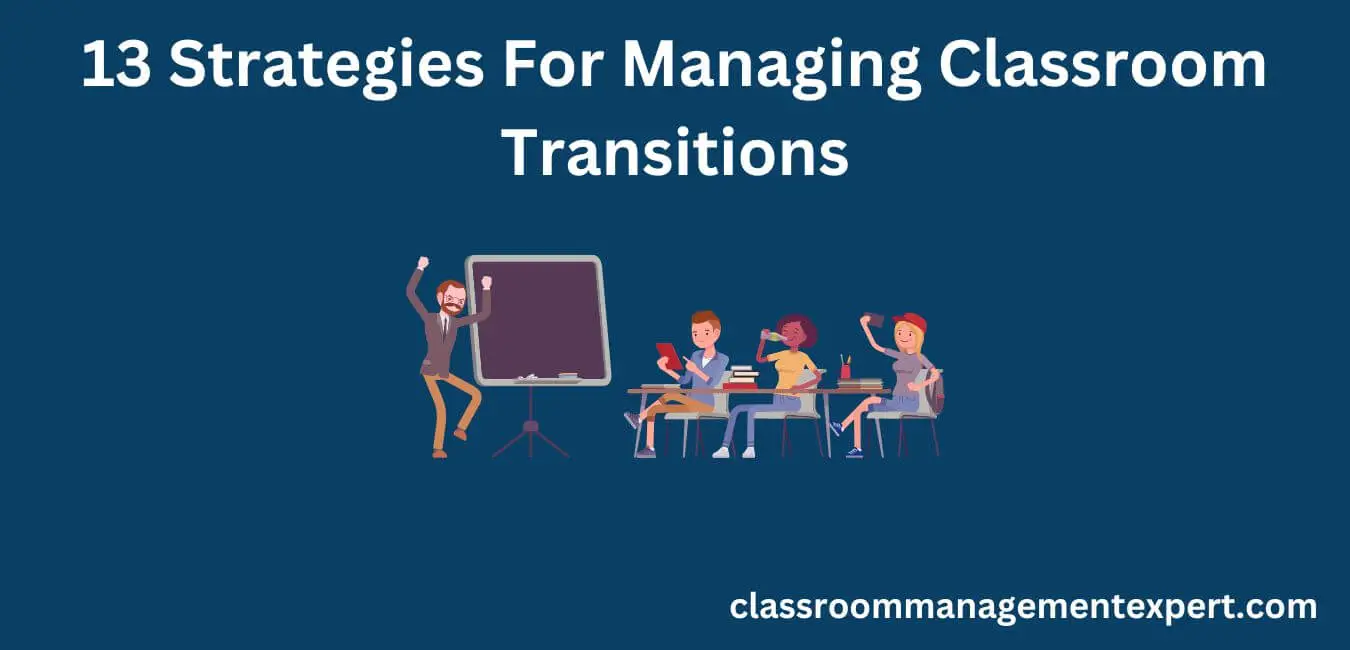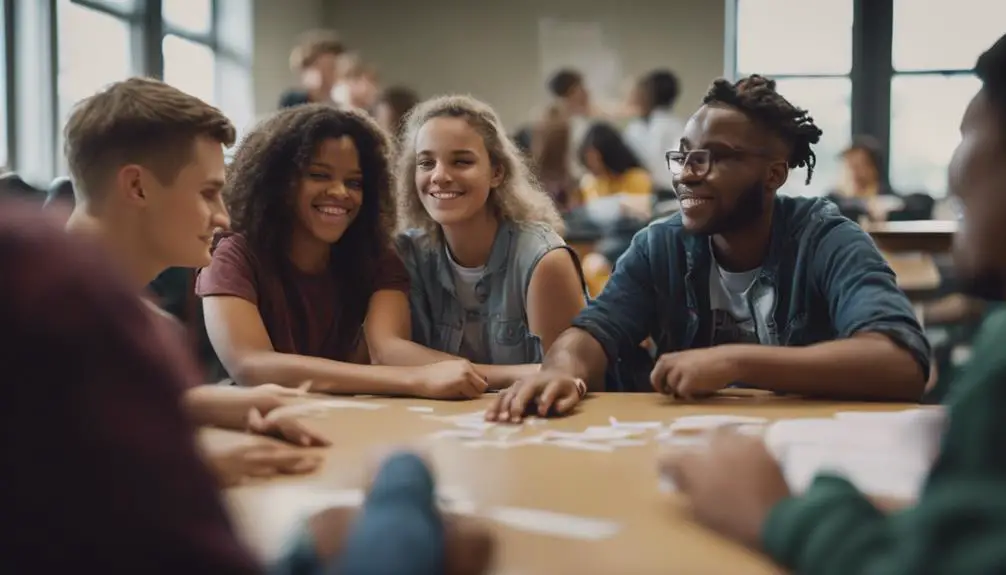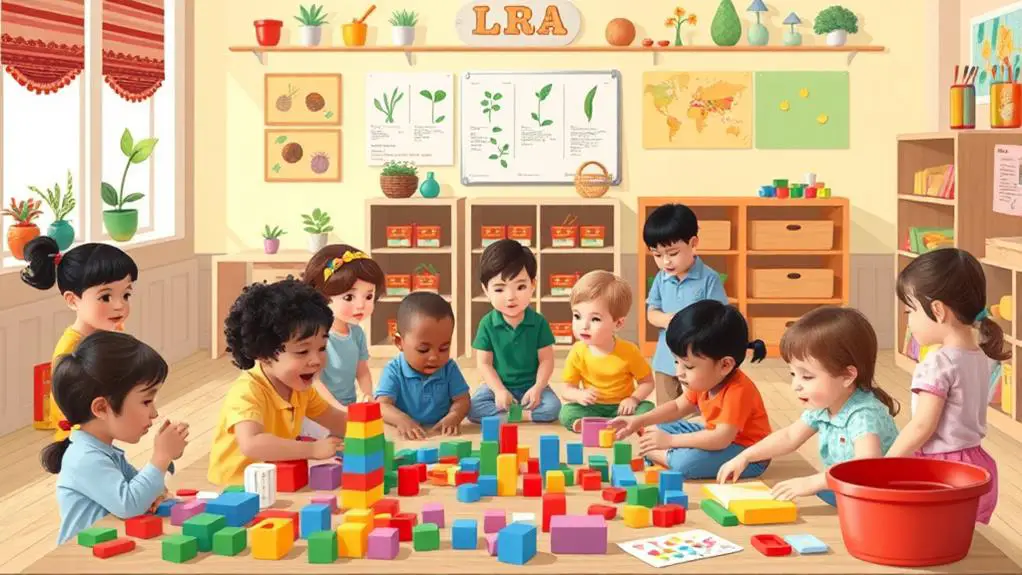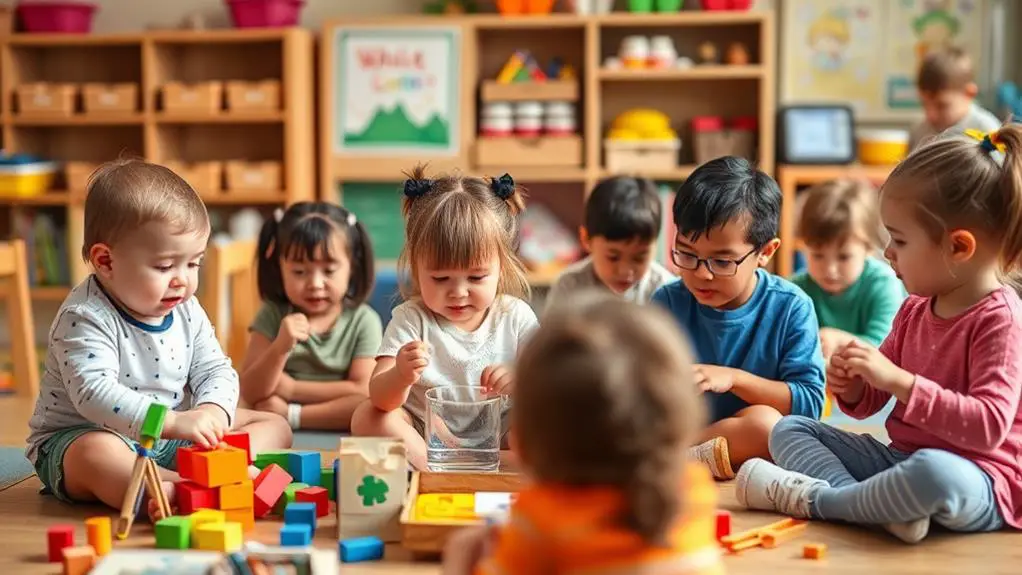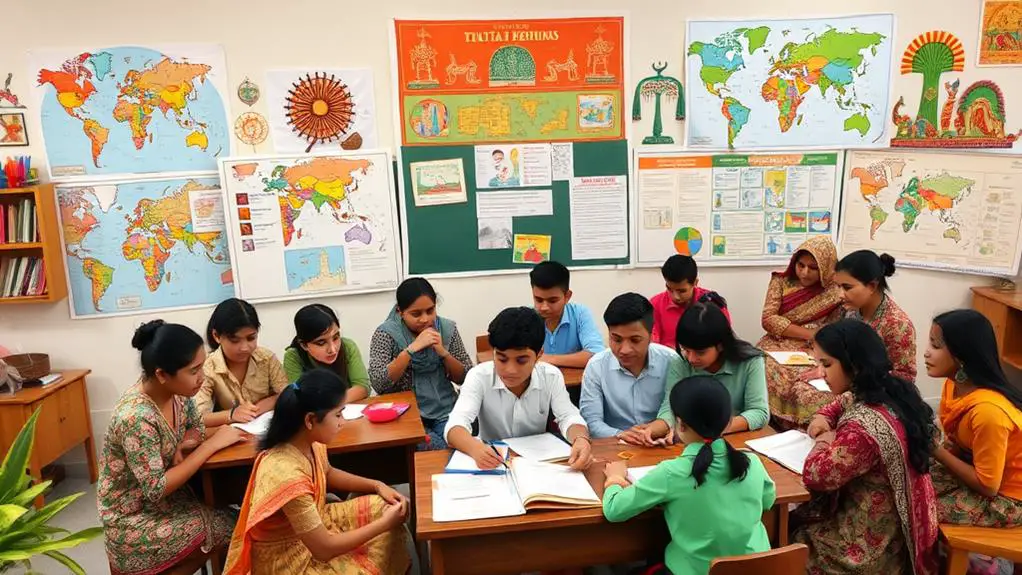To achieve sustainable success in a peer mediation program, focus on a combination of effective training techniques, team-building exercises, and continuous assessment.
Enhance communication, trust, and problem-solving abilities within your mediator groups.
Involve all stakeholders and cultivate a supportive school environment.
Establish clear objectives, prioritize the well-being of mediators, and be adaptable to changes within the school setting.
Acknowledge accomplishments and maintain visibility of the program.
Implementing these strategies will ensure the longevity and positive impact of your peer mediation initiative.
For more in-depth insights on maximizing program success, refer to the detailed research available.
Understanding Peer Mediation Programs
Understanding peer mediation programs is crucial for their successful implementation and impact within a school community. Assessing the program’s impact involves not only immediate resolutions but also long-term effects on the school environment. Analyzing data and feedback from participants allows us to tailor the program to address specific needs and continuously enhance its effectiveness.
Mediator retention significantly influences the sustainability of peer mediation programs. Establishing a supportive and engaging environment for student mediators is essential to ensure their commitment. Regular check-ins, training sessions, and acknowledgment of their contributions can boost morale and motivation, leading to a higher retention rate. Offering opportunities for personal and professional growth can further incentivize students to stay involved and actively contribute to the program’s success.
Ultimately, understanding the program’s impact and prioritizing mediator retention are key elements in maintaining a thriving peer mediation initiative in a school community.
Building Strong Mediator Teams
To cultivate strong mediator teams, it’s vital to enhance communication and collaboration among members. Team bonding activities like icebreakers, group challenges, and discussions can help build trust and unity. Techniques such as active listening, brainstorming, and peer feedback contribute to improving problem-solving abilities and fostering a supportive team atmosphere.
Alongside team building, strategies to motivate and retain mediators play a crucial role in maintaining a robust team. Recognizing mediators’ hard work through shoutouts, certificates, or small rewards can uplift morale and inspire continued dedication. Offering continuous training opportunities, mentorship programs, and avenues for career growth can also enhance mediator satisfaction and commitment to the team.
Implementing Effective Training Strategies
Effective training strategies are crucial for arming peer mediators with the essential skills and knowledge needed for successful conflict resolution. Interactive workshops offer a vibrant platform for peer mediators to acquire and practice mediation techniques in a supportive setting. Through role-playing scenarios, mediators can simulate real-life conflict situations, refining their communication and problem-solving abilities.
Virtual simulations provide a valuable opportunity for peer mediators to practice mediation in a digital environment, preparing them for a variety of potential scenarios they may encounter. Engaging in group activities fosters collaboration and teamwork among mediators, prompting them to glean insights from each other’s experiences and perspectives.
Fostering School-wide Support
Gaining staff buy-in is crucial for the success of a peer mediation program. Actively involving students through effective strategies can also significantly contribute to the program’s long-term sustainability. Clear communication channels established throughout the school community are vital in garnering school-wide support.
To ensure the peer mediation program’s effectiveness, fostering a sense of ownership among staff members is key. This can be achieved through workshops, training sessions, and open discussions to help them understand the program’s benefits and their role in its success.
Engaging students in the process by empowering them to take on active roles as peer mediators or ambassadors can create a sense of investment and commitment to the program.
Furthermore, maintaining open lines of communication with all stakeholders, including parents, teachers, and administrators, is essential. Regular updates, progress reports, and feedback mechanisms can help keep everyone informed and engaged.
Staff Buy-In Importance
When working to establish a sustainable peer mediation program, it’s crucial to secure staff support to ensure school-wide backing. Staff motivation is key to the long-term success of the program.
Here are three essential factors to consider when seeking staff buy-in:
- Leadership Endorsement: It’s vital for administrators and school leaders to actively champion the peer mediation program. Their backing can effectively communicate the program’s significance to the staff, leading to increased support and engagement.
- Staff Participation: Engage staff members by providing opportunities for them to contribute ideas and feedback to the program. When staff feel that their input is valued, they’re more likely to actively support and engage in the peer mediation initiative.
- Professional Growth: Offer training sessions or workshops to equip staff with the necessary skills and knowledge to effectively support the program. Investing in staff development helps cultivate a sense of ownership and expertise, strengthening their commitment to the peer mediation effort.
Student Involvement Strategies
To cultivate widespread support for a peer mediation program in school, it’s essential to actively involve students in key decision-making processes. Peer recruitment is pivotal for the program’s success, and students should be empowered to spearhead this effort. Encouraging students to pinpoint potential mediators among their peers can boost program visibility and participation.
Empowering students is crucial for nurturing a supportive atmosphere for the peer mediation program. By entrusting students to lead initiatives like organizing awareness campaigns or overseeing mediation sessions, a sense of ownership and accountability is fostered. This not only enhances the program’s efficacy but also fosters a positive school environment where conflicts are resolved constructively.
Incorporating students into decision-making processes and empowering them to assume leadership roles not only fortifies the peer mediation program but also fosters a spirit of community and collaboration within the school. By actively involving students in these capacities, we can establish a sustainable program that benefits the entire school community.
Communication Channels Established
Establishing effective communication channels within the school is crucial for gaining support for the peer mediation program. To accomplish this, we can employ various strategies:
- Utilizing Diverse Communication Methods:
Mix traditional approaches like flyers, announcements, and newsletters with modern methods such as social media posts and email updates to effectively reach a wider audience.
- Leveraging Online Platforms:
Take advantage of school websites, virtual meetings, and discussion forums to engage with students, parents, and staff members consistently, ensuring seamless information sharing.
- Encouraging Parent Engagement and Community Collaboration:
Host informative sessions for parents to familiarize them with the peer mediation program’s advantages. Additionally, partner with community organizations to raise awareness and garner external support for this initiative.
Ensuring Continuous Evaluation
Let’s delve into the significance of continuous evaluation to sustain a peer mediation program.
This involves carefully choosing assessment tools, applying effective data analysis techniques, and creating action plans for improvement based on the assessment results.
Implementing a strong system of continuous assessment ensures that the peer mediation program remains efficient and adaptable to the changing needs of the school community.
Evaluation Tools Selection
Selecting the right evaluation tools is crucial for assessing and enhancing the effectiveness of a peer mediation program. To ensure a thorough evaluation of the program’s impact, several key steps should be taken:
- Gathering Feedback from Stakeholders: Surveys should be conducted among participants, mediators, teachers, and administrators to collect a variety of viewpoints on the program’s strengths and areas needing improvement. These surveys offer valuable insights into how the peer mediation initiative is perceived and its overall impact.
- Direct Observation of Mediation Sessions: Regularly observing peer mediation sessions provides firsthand insights into the dynamics, effectiveness, and challenges encountered during the mediation process. This direct observation helps in understanding how mediation skills are applied in practice and the overall effectiveness of the program.
- Utilizing Feedback Forms: Implementing feedback forms after each mediation session allows for the collection of immediate reactions and suggestions for enhancement. These forms serve as quick evaluation tools to capture real-time feedback on the mediation process and pinpoint any trends that require attention.
Data Analysis Techniques
Maintaining the ongoing efficiency of a peer mediation program requires the use of suitable data analysis techniques for continuous evaluation. Statistical analysis is essential for interpreting the data collected from mediation sessions. Through statistical methods, we can uncover trends, patterns, and correlations within the data, enabling us to make well-informed decisions regarding the program’s impact and areas for improvement.
Data visualization tools such as graphs, charts, and dashboards can aid in presenting the data clearly and concisely, facilitating stakeholders’ understanding and action based on the insights gained.
Ensuring the accuracy and reliability of the data is paramount when conducting statistical analysis by employing appropriate statistical tests and methods. This approach allows us to derive meaningful outcomes that guide us in enhancing the efficiency of the peer mediation program. Furthermore, the use of data visualization techniques can help effectively communicate these findings to stakeholders, promoting transparency and collaboration in the continuous evaluation process.
Improvement Action Planning
Improvement action planning plays a crucial role in enhancing the efficiency of a peer mediation program. To ensure continuous evaluation and refinement, it’s essential to focus on refining action plans and implementing sustainable strategies.
Here are three key aspects to consider in improvement action planning:
- Regular Review: Conduct periodic assessments of the peer mediation program’s performance to pinpoint areas for enhancement. Gathering feedback from mediators, participants, and stakeholders can provide valuable insights into strengths and areas needing improvement.
- Setting Measurable Goals: Define clear and measurable objectives for program advancement. Establish specific targets related to the number of mediations, participant satisfaction levels, and impact assessment metrics to monitor progress over time.
- Flexibility and Adaptability: Stay open to adjusting strategies based on feedback and assessment outcomes. Being adaptable allows for ongoing improvement, ensuring that the peer mediation program remains effective and relevant in achieving its goals.
Cultivating Conflict Resolution Skills
Let’s delve into the development of conflict resolution skills, which are crucial for creating a positive and collaborative atmosphere in any peer mediation program. By exploring and honing our abilities in conflict resolution and communication, we can effectively assist others in resolving disputes and fostering harmony within our communities.
To cultivate these vital skills, we can focus on key areas such as active listening, problem-solving, emotional intelligence, and mediation techniques. Active listening allows us to grasp different perspectives, while problem-solving skills aid in finding mutually beneficial solutions.
Emotional intelligence helps us navigate emotions, and mediation techniques combined with clear communication facilitate productive discussions. Mastering these skills will significantly contribute to the success and longevity of our peer mediation program.
Encouraging Peer Involvement
Let’s delve into the strategies, opportunities, and initiatives designed to enhance peer involvement in our mediation program.
Peer engagement plays a crucial role in fostering a sense of community and shared responsibility among participants. Providing leadership roles and specialized training can empower peers to actively participate in conflict resolution processes. This active involvement not only strengthens the mediation program but also promotes a collaborative environment where individuals can support each other through challenging situations.
It’s important to create avenues for peers to contribute their unique perspectives and skills, ultimately enriching the overall mediation experience for everyone involved.
Peer Engagement Strategies
Peer involvement in a Peer Mediation Program can be nurtured through interactive training sessions and fostering a culture of inclusivity within the peer group. To encourage peer engagement effectively, consider the following strategies:
- Peer Support: Creating a system where peers can help each other fosters a sense of community and trust within the mediation program. Peer support may involve regular check-ins, group discussions, and providing a safe space for sharing experiences.
- Engagement Activities: Hosting engaging activities like team-building exercises, role-playing scenarios, and collaborative projects can spark interest and active participation among peers. These activities not only enhance communication skills but also build a sense of belonging and teamwork within the group.
- Feedback Mechanisms: Introducing feedback mechanisms enables peers to express their thoughts, concerns, and suggestions for improvement. This open communication channel ensures that all voices are heard and valued, promoting a culture of continuous growth and development within the program.
Peer Leadership Opportunities
To enhance peer engagement within a Peer Mediation Program, it can be beneficial to explore opportunities for peer leadership. This strategy involves providing mentorship opportunities and fostering leadership development among peers, which ultimately cultivates a sense of ownership and commitment to the program. Encouraging peer involvement in leadership roles not only supports their personal growth but also enhances the overall mediation process.
One way to implement peer leadership is through Mentorship Opportunities, where experienced peers guide newer members through the mediation process. This approach encourages knowledge sharing and helps build a supportive community within the program.
Additionally, Leadership Development initiatives such as training sessions and workshops can empower peers to take on responsibilities and lead effectively, further enhancing their skills and confidence.
Another avenue for peer leadership is through Community Service, involving organizing mediation sessions for the community or school events. This not only fosters a sense of giving back but also allows peers to make a positive impact through their mediation skills.
Furthermore, engaging in Team Building activities within the mediation team can strengthen bonds and boost collaboration and communication skills among peers, creating a more cohesive and effective group.
Peer Training Initiatives
Engaging peers through interactive training sessions plays a crucial role in enhancing their involvement and skill development within the Peer Mediation Program. As a peer mediator, I’ve experienced firsthand the importance of peer training initiatives in improving our ability to offer effective peer support and facilitate conflict resolution.
Here are three key strategies to promote peer participation through training:
- Interactive Workshops: Hosting dynamic workshops that concentrate on active listening, empathy building, and effective communication techniques is essential. These workshops equip peers with practical skills that empower them to handle conflicts constructively.
- Role-Playing Exercises: Including role-playing activities in training sessions to simulate real-life conflict scenarios is highly beneficial. Through practicing mediation techniques in a safe environment, peers can boost their confidence in facilitating peaceful resolutions.
- Ongoing Mentorship: Establishing a mentorship system where experienced peer mediators mentor and support newer members is vital. This peer support network fosters a sense of community and encourages continuous learning and growth within the program.
Promoting Program Visibility
Increasing the visibility of our peer mediation program is crucial for attracting participants and garnering community support. Utilizing social media platforms like Facebook, Instagram, and Twitter can effectively reach a broad audience. Regularly sharing updates, success stories, and details about upcoming events helps engage our community and keeps them informed about the impactful work happening through our program.
Community events serve as a powerful tool for promoting our peer mediation program. Hosting workshops, open houses, or informational sessions at local schools, libraries, or community centers enables direct interaction with potential participants and stakeholders. These events provide a platform to showcase our program’s influence, address inquiries, and recruit new members.
Engaging with our community through various outreach efforts ensures that our peer mediation program remains visible and continues to make a positive impact.
Securing Adequate Funding
Securing sustainable funding for our peer mediation program is essential for its long-term viability and success. To ensure we’ve the financial resources needed to continue our impactful work, we focus on the following key strategies:
- Diversifying Funding Sources: Exploring various avenues such as grants, donations, and partnerships reduces dependency on a single source of funding, guaranteeing stability even if one source fluctuates.
- Developing In-depth Sustainability Plans: Creating detailed sustainability plans that outline long-term financial goals, potential risks, and strategies to mitigate them helps us stay proactive and prepared for any funding challenges that may arise.
- Effective Budget Management and Fundraising Strategies: Implementing efficient budget management practices allows us to allocate resources wisely. Engaging in effective fundraising strategies like hosting events, crowdfunding campaigns, and engaging with donors helps us secure the necessary funds to sustain our program.
Establishing Clear Program Goals
Establishing clear program goals is crucial for guiding our actions and measuring the success of our peer mediation initiative. Aligning our goals ensures that everyone is working towards a common vision, fostering unity and focus. Engaging stakeholders in this process is key, as it allows for input from all parties involved, creating a sense of ownership and commitment.
Defining our program goals clearly lays the groundwork for sustainability. Having measurable objectives enables us to track progress and make informed decisions to enhance our impact. When goals are specific, measurable, achievable, relevant, and time-bound (SMART), they become more attainable and motivating for all participants.
As we strive for the sustainability of our peer mediation program, it’s essential to regularly review and adjust our goals in collaboration with stakeholders. This iterative approach ensures that our program remains effective, relevant, and aligned with the needs of our community.
Emphasizing Mediator Well-being
Prioritizing the well-being of mediators is crucial to the sustained success of our peer mediation program. As mediators, it’s essential to take care of ourselves to effectively support others.
Here are three key strategies to promote mediator well-being:
- Mediator Self-Care: Encouraging mediators to engage in self-care practices like mindfulness exercises, setting boundaries, and taking necessary breaks can help prevent burnout and enhance their ability to assist their peers effectively.
- Team Support: Cultivating a supportive environment within the mediation team is vital. Regular team check-ins, peer support sessions, and opportunities for mediators to discuss challenging cases can foster a sense of camaraderie and teamwork.
- Training and Development: Offering ongoing training sessions focused on stress management, conflict resolution techniques, and self-reflection equips mediators with the necessary tools to navigate intricate mediation scenarios while safeguarding their well-being.
Adapting to Changing School Dynamics
Navigating the ever-changing landscape of school dynamics mandates a flexible and responsive approach to meet the evolving needs of our peer mediation program. As advocates for students, it’s crucial to stay attuned to shifts in school culture that could impact our mediation efforts’ efficacy.
Engaging actively with students, teachers, and administrators provides valuable insights into the changing dynamics within the school environment.
Being adaptable to shifting school dynamics entails a readiness to embrace new approaches and strategies that resonate with the current student body’s requirements. Whether it involves addressing newly arising conflicts or supporting mental health initiatives, our peer mediation program must be quick to respond to the changing landscape of student welfare.
Celebrating Program Successes
To effectively showcase the impact of our peer mediation program, it’s essential to recognize and celebrate its successes. Celebrating program achievements is key to boosting morale, building a sense of community, and attracting more student participation.
Here are three effective ways to celebrate our peer mediation program accomplishments and honor the students who contribute to its success:
- Celebration Events: Consider organizing special events like awards ceremonies or appreciation gatherings to publicly acknowledge the hard work and dedication of peer mediators. These events provide a platform to share success stories and inspire others to join in.
- Student Recognition: Establish a system to regularly commend and highlight the efforts of individual students in the program. Whether through certificates, mentions in school newsletters, or social media posts, recognizing student contributions can inspire them to continue making a positive difference.
- Showcasing Success Stories: Share real success stories from the program to illustrate the positive outcomes of peer mediation. Highlighting examples of conflict resolution and improved relationships can demonstrate the program’s effectiveness and encourage others to engage.
Conclusion
In the end, maintaining a peer mediation program is like tending to a garden – it requires ongoing care, attention, and nurturing.
Building strong mediator teams, implementing effective training strategies, and fostering school-wide support are essential for ensuring the program thrives.
Just as flowers need water and sunlight to grow, peer mediation programs need dedication and commitment to flourish.
With these 13 strategies for success, we can cultivate a culture of peace and understanding in our schools.

